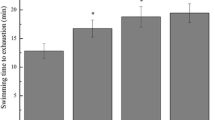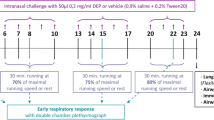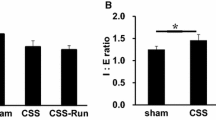Abstract
In this study, we evaluated the effects of high-intensity swimming in an experimental model of acute lung injury (ALI) induced by lipopolysaccharide (LPS) on lung inflammation and antioxidant defenses. Balb/C male mice were submitted to exercise (30 min/day, 5 days/week, for a period of 3 weeks) prior to LPS instillation in the lung. Twenty-four hours after delivery of LPS (10 μg/animal), mice were euthanized and bronchoalveolar fluid (BALF) was obtained for cell counting and analysis of cytokines by ELISA. Lung tissue was used to evaluate antioxidant defenses. LPS instillation resulted in an increase in total and mononuclear cells, IL-1β, TNF-α, and IL-6 in BALF. LPS instillation also altered IL-10 and IL-ra levels in BALF and induced antioxidant defenses (glutathione, superoxide dismutase, catalase, and glutathione peroxidase) in the lung. Protein carbonyl increased in the LPS-treated animals. High-intensity swimming prevented all these changes induced by LPS. Significance: Therefore, this experimental protocol of high-intensity swimming showed a protective effect on ALI, decreasing inflammatory processes and preventing disturbances in antioxidant defenses into the lungs.






Similar content being viewed by others
References
Matthay, M.A., L.B. Ware, and G.A. Zimmerman. 2012. The acute respiratory distress syndrome. The Journal of Clinical Investigation 122 (8): 2731–2740.
ARDS Definition Task Force. Ranieri, V.M., G.D. Rubenfeld, B.T. Thompson, N.D. Ferguson, E. Caldwell, E. Fan, L. Camporota and a.S. Slutsky. 2012. Acute respiratory distress syndrome: the Berlin Definition. The Journal of the American Medical Association 307 (23): 2526–2533.
Bein, T., S. Grasso, O. Moerer, M. Quintel, C. Guerin, M. Deja, A. Brondani, and S. Mehta. 2016. The standard of care of patients with ARDS: ventilatory settings and rescue therapies for refractory hypoxemia. Intensive Care Medicine 42 (5): 699–711.
Matute-Bello, G., C.W. Frevert and T.R. Martin. 2008. Animal models of acute lung injury. The American Journal of Physiology Lung Cellular and Moleular Physiology 295 (3): 379–399.
Chen, H., C. Bai, and X. Wang. 2010. The value of the lipopolysaccharide-induced acute lung injury model in respiratory medicine. Expert Review of Respiratory Medicine 4 (6): 773–783.
Ulich, T.R., L.R. Watson, S.M. Yin, K.Z. Guo, P. Wang, H. Thang, and J. del Castillo. 1991. The intratracheal administration of endotoxin and cytokines. I. Characterization of LPS-induced IL-1 and TNF mRNA expression and the LPS-, IL-1-, and TNF-induced inflammatory infiltrate. American Journal of Pathology 138 (6): 1485–1496.
Ward, P.A. 2010. Oxidative stress: acute and progressive lung injury. Annals of the New York Academy of Science 1203: 53–59.
Sarma, J.V., and P.A. Ward. 2011. Oxidants and redox signaling in acute lung injury. Comprehensive Physiology 1 (3): 1365–1381.
Wilcox, M.E., and M.S. Herridge. 2011. Lung function and quality of life in survivors of the acute respiratory distress syndrome (ARDS). La Presse Médicale 40 (12): 595–603.
Vieira, R.P., A.C. Toledo, L.B. Silva, F.M. Almeida, N.R. Damaceno-Rodrigues, E.G. Caldini, A.B.G. Santos, D.H. Rivero, D.C. Hizume, F.D.T.Q.S. Lopes, C.R. Olivo, H.C. Castro-Faria-Neto, M.A. Martins, P.H.N. Saldiva, and M. Dolhnikoff. 2012. Anti-inflammatory effects of aerobic exercise in mice exposed to air pollution. Medicine and Science in Sports and Exercise 44 (7): 1227–1234.
Souza, L.C., C.B. Filho, A.T.R. Goes, L.D. Fabbro, M.G. de Gomes, L. Savegnago, M.S. Oliveira, and C.R. Jesse. 2013. Neuroprotective effect of physical exercise in a mouse model of Alzheimer’s disease induced by β-amyloid1 40 peptide. Neurotoxicity Research 24 (2): 148–163.
Ávila, L.C.M., T.R. Bruggemann, F. Bobinski, M.D. da Silva, R.C. Oliveira, D.F. Martins, L. Mazzardo-Martins, M.M.M.F. Duarte, L.F. de Souza, A. Dafre, R. de P. Vieira, A.R.S. Santos, K.C. Bonorino, and D. de C. Hizume Kunzler. 2015. Effects of high-intensity swimming on lung inflammation and oxidative stress in a murine model of DEP-induced injury. Public Library of Science 10 (9).
Petersen, A.M.W., and B.K. Pedersen. 2005. The anti-inflammatory effect of exercise. Journal of Applied Physiology 98 (4): 1154–1162.
Balducci, S., S. Zanuso, A. Nicolucci, F. Fernando, S. Cavallo, P. Cardelli, S. Fallucca, E. Alessi, C. Letizia, A. Jimenez, F. Fallucca, and G. Pugliese. 2010. Anti-inflammatory effect of exercise training in subjects with type 2 diabetes and the metabolic syndrome is dependent on exercise modalities and independent of weight loss. Nutrition, Metabolism and Cardiovascular Diseases 20 (8): 608–617.
Brüggemann, T.R., L.C.M. Ávila, B. Fortkamp, F.R. Greiffo, F. Bobinski, L. Mazzardo-Martins, D.F. Martins, M.M.M.F. Duarte, A. Dafre, A.R.S. Santos, M.D. Silva, L.F. Souza, R.P. Vieira, and D.C. Hizume-Kunzler. 2015. Effects of swimming on the inflammatory and redox response in a model of allergic asthma. International Journal of Sports Medicine 36 (2): 579–584.
Kuphal, K.E., E.E. Fibuch, and B.K. Taylor. 2007. Extended swimming exercise reduces inflammatory and peripheral neuropathic pain in rodents. The Journal of Pain 8 (12): 989–997.
Ferreira, J.C.B., N.P.L. Rolim, J.B. Bartholomeu, C.A. Gobatto, E. Kokubun, and P.C. Brum. 2007. Maximal lactate steady state in running mice: effect of exercise training. Clinical and Experimental Pharmacology Physiology 34 (8): 760–765.
Akerboom, T.P., and H. Sies. 1981. Assay of glutathione, glutathione disulfide, and glutathione mixed disulfides in biological samples. Methods in Enzymology 77: 373–382.
Wendel, A. 1981. Glutathione peroxidase. Methods in Enzymology 77: 325–333.
Aebi, H. 1984. Catalase in vitro. Methods in Enzymology 105: 121–126.
Paoletti, F., D. Aldinucci, A. Mocali, and A. Caparrini. 1986. A sensitive spectrophotometric method for the determination of superoxide dismutase activity in tissue extracts. Analytical Biochemistry 154 (4): 536–541.
Levine, R.L., J.A. Williams, E.R. Stadtman, and E. Shacter. 1994. Carbonyl assays for determination of oxidatively modified proteins. Methods in Enzymology 233: 346–357.
Sato, K., M.B. Kadiiska, A.J. Ghio, J. Corbett, Y.C. Fann, S.M. Holland, R.G. Thurman, and R.P. Mason. 2002. In vivo lipid-derived free radical formation by NADPH oxidase in acute lung injury induced by lipopolysaccharide: a model for ARDS. Federation of American Societies for Experimental Biology 16 (13): 1713–1720.
Hagiwara, S., H. Iwasaka, K. Togo and T. Noguchi, A. 2008. Neutrophil elastase inhibitor, sivelestat, reduces lung injury following endotoxin-induced shock in rats by inhibiting HMGB1. Inflammation 31 (4) 227–234.
Ramos, D.S., C.R. Olivo, F.D.T. Quirino Santos Lopes, A.C. Toledo, M.A. Martins, R.A. Lazo Osório, M. Dolhnikoff, W. Ribeiro, and R. de P. Vieira. 2010. Low-intensity swimming training partially inhibits lipopolysaccharide-induced acute lung injury. Medicine and Science in Sports and Exercise 42 (1): 113–119.
Reis Gonçalves, C.T., C.G. Reis Gonçalves, F.M. de Almeida, F.D.T.Q. dos Santos Lopes, A.C.C. dos Santos Durão, F.A. dos Santos, L.F.F. da Silva, T. Marcourakis, H.C. Castro-Faria-Neto, R. de P. Vieira, and M. Dolhnikoff. 2012. Protective effects of aerobic exercise on acute lung injury induced by LPS in mice. Critical Care 16 (5): R199.
Olivo, C.R., E.N. Miyaji, M.L.S. Oliveira, F.M. Almeida, J.D. Lourenço, R.M. Abreu, P.M.M. Arantes, F.D. Lopes, and M.A. Martins. 2014. Aerobic exercise attenuates pulmonary inflammation induced by Streptococcus pneumoniae. Journal of Applied Physiology 117 (9): 998–1007.
Luks, V., A. Burkett, L. Turner, and S. Pakhale. 2013. Effect of physical training on airway inflammation in animal models of asthma: a systematic review. BMC Pulmonary Medicine 13: 24.
Reutershan, J., M.A. Morris, T.L. Burcin, D.F. Smith, D. Chang, M.S. Saprito, and K. Ley. 2006. Critical role of endothelial CXCR2 in LPS-induced neutrophil migration into the lung. The Journal of Clinical Investigation 116 (3): 695–702.
Decker, T., M.L. Lohmann-Matthes, and G.E. Gifford. 1987. Cell-associated tumor necrosis factor (TNF) as a killing mechanism of activated cytotoxic macrophages. The Journal of Immunology 138 (3): 957–962.
Guo, H., J.B. Callaway, and J.P.-Y. Ting. 2015. Inflammasomes: mechanism of action, role in disease, and therapeutics. Nature Medicine 21 (7): 677–687.
Xu, S., M. Xu, G.-G. Li, C. Wang, H. Song, and J. Bai. 2016. Early recruitment of IL-10-producing B cells into alveoli improved the resolution of acute lung injury. Cellular Physiology and Biochemistry 38 (5): 1752–1760.
Park, H.S., S.R. Kim, and Y.C. Lee. 2009. Impact of oxidative stress on lung diseases. Respirology 14 (1): 27–38.
Rosanna, D.P., and C. Salvatore. 2012. Reactive oxygen species, inflammation, and lung diseases. Current Pharmaceutical Design 18 (26): 3889–3900.
Sittipunt, C., K.P. Steinberg, J.T. Ruzinski, C. Myles, S. Zhu, R.B. Goodman, L.D. Hudson, S. Matalon, and T.R. Martin. 2001. Nitric oxide and nitrotyrosine in the lungs of patients with acute respiratory distress syndrome. American Journal of Respiratory and Critical Care Medicine 163 (2): 503–510.
da Cunha, A.A., F.B. Nunes, A. Lunardelli, V. Pauli, R.H. Amaral, L.M. de Oliveira, V.C. Saciura, G.L. da Silva, M.G.S. Pires, M.V.F. Donadio, D.A. da S. Melo, F. Dal-Pizzol, J.C.F. Moreira, G.A. Behr, C.L. Reichel, J.L. Rosa, and J.R. de Oliveira. 2011. Treatment with N-methyl-d-aspartate receptor antagonist (MK-801) protects against oxidative stress in lipopolysaccharide-induced acute lung injury in the rat. International Immunopharmacology 11 (6): 706–711.
Mitchell, J., H. Jiang, L. Berry, and B. Meyrick. 1996. Effect of antioxidants on lipopolysaccharide-stimulated induction of mangano superoxide dismutase mRNA in bovine pulmonary artery endothelial cells. Journal of Cellular Physiology 169 (2): 333–340.
Dirami, G., D. Massaro, and L.B. Clerch. 1999. Regulation of lung manganese superoxide dismutase: species variation in response to lipopolysaccharide. American Journal of Physiology 276 (5 Pt 1): L705–L708.
Lima Trajano, E.T., C. Sternberg, M. Caetano, M.A. Santos Silva, L.C. Porto, J.C. Santos, M.L. Ribeiro, C.B. Magalhães, W.A. Zin, C.F. Benjamim, and S.S. Valença. 2011. Endotoxin-induced acute lung injury is dependent upon oxidative response. Inhalation Toxicology 23 (14): 918–926.
Biolo, G., R. Antonione, and M. De Cicco. 2007. Glutathione metabolism in sepsis. Critical Care Medicine 35 (9): S591–S595.
Malmezat, T., D. Breuillé, P. Capitan, P.P. Mirand, and C. Obled. 2000. Glutathione turnover is increased during the acute phase of sepsis in rats. Journal of Nutrition 130 (5): 1239–1246.
Nakasone, M., K. Nakaso, Y. Horikoshi, T. Hanaki, Y. Kitagawa, T. Takahashi, Y. Inagaki, and T. Matsura. 2016. Preconditioning by low dose LPS prevents subsequent LPS-induced severe liver injury via Nrf2 activation in mice. Yonago Acta Medica 59 (3): 223–231.
Yu, J., J. Shi, L. Gong, S. Dong, Y. Xu, Y. Zhang, X. Cao, and L. Wu. 2014. Role of Nrf2/ARE pathway in protective effect of electroacupuncture against endotoxic shock-induced acute lung injury in rabbits. Public Library of Science 9 (8): e104924.
Yeh, C.H., J.J. Yang, M.L. Yang, Y.C. Li, and Y.H. Kuan. 2014. Rutin decreases lipopolysaccharide-induced acute lung injury via inhibition of oxidative stress and the MAPK–NF-κB pathway. Free Radical Biology and Medicine 69: 249–257.
Su, Z.Q., Z.Z. Mo, J.B. Liao, X.X. Feng, Y.Z. Liang, X. Zhang, Y.H. Liu, X.Y. Chen, Z.W. Chen, Z.R. Su, and X.P. Lai. 2014. Usnic acid protects LPS-induced acute lung injury in mice through attenuating inflammatory responses and oxidative stress. International Immunopharmacology 22 (2): 371–378.
Du, Q., C. Wang, N. Zhang, G. Li, M. Zhang, L. Li, Q. Zhang, and J. Zhang. 2014. In vivo study of the effects of exogenous hydrogen sulfide on lung mitochondria in acute lung injury in rats. BMC Anesthesiology 14: 117.
Dos Santos Cunha, W.D., M.V. Giampietro, D.F. De Souza, M. Vaisberg, M.C.L. Seelaender, and L.F. Rosa. 2004. Exercise restores immune cell function in energy-restricted rats. Medicine and Science in Sports and Exercise 36 (12): 2059–2064.
Heffner, J.E., and J.E. Repine. Pulmonary strategies of antioxidant defense. The American Review of Respiratory Disease 140 (2): 531–554.
Funding
This work was supported by the State University of Santa Catarina and Research Support Foundation of Santa Catarina.
Author information
Authors and Affiliations
Corresponding author
Ethics declarations
This study was approved by the Review Board for Animal Studies of the Federal University of Santa Catarina (PP 00745). All animals in this study received humane care in compliance with EU Directive 2010/63/EU, which provides guidelines for animal experiments.
Rights and permissions
About this article
Cite this article
Cardoso, G.H., Petry, D.M., Probst, J.J. et al. High-Intensity Exercise Prevents Disturbances in Lung Inflammatory Cytokines and Antioxidant Defenses Induced by Lipopolysaccharide. Inflammation 41, 2060–2067 (2018). https://doi.org/10.1007/s10753-018-0849-9
Published:
Issue Date:
DOI: https://doi.org/10.1007/s10753-018-0849-9




